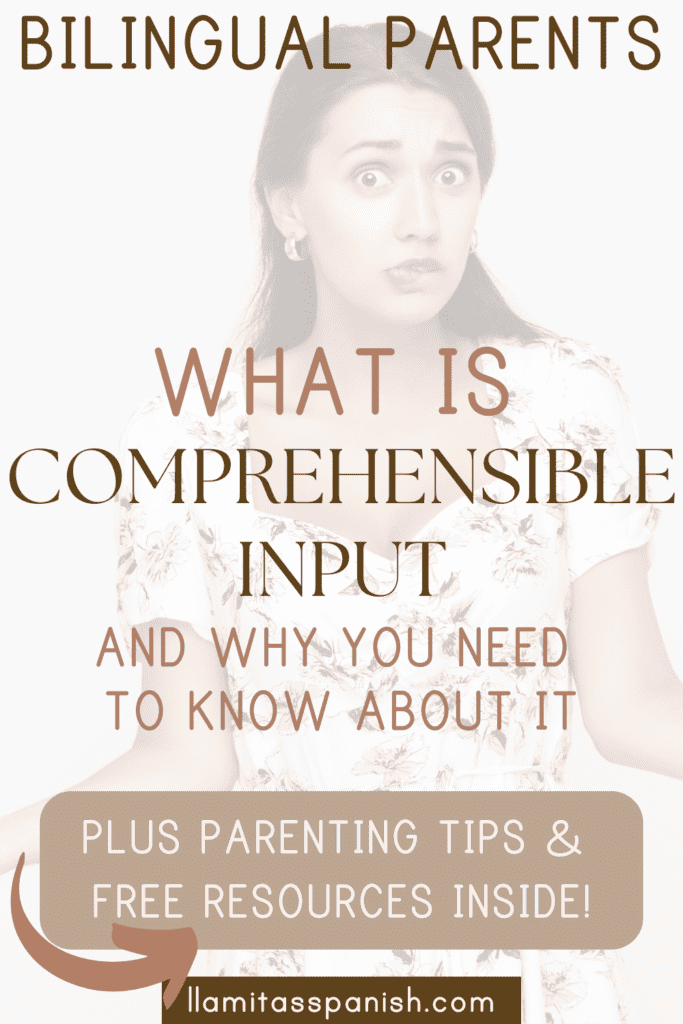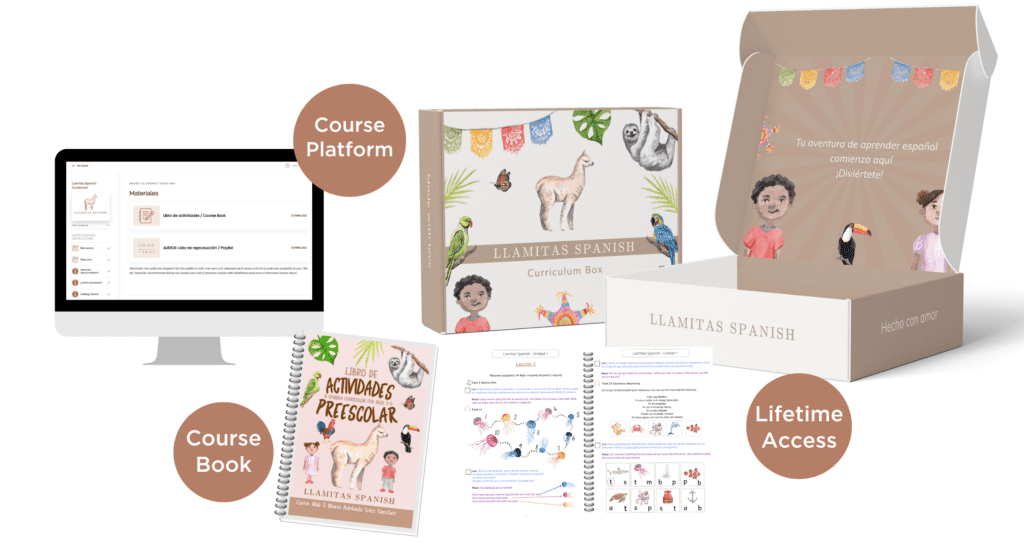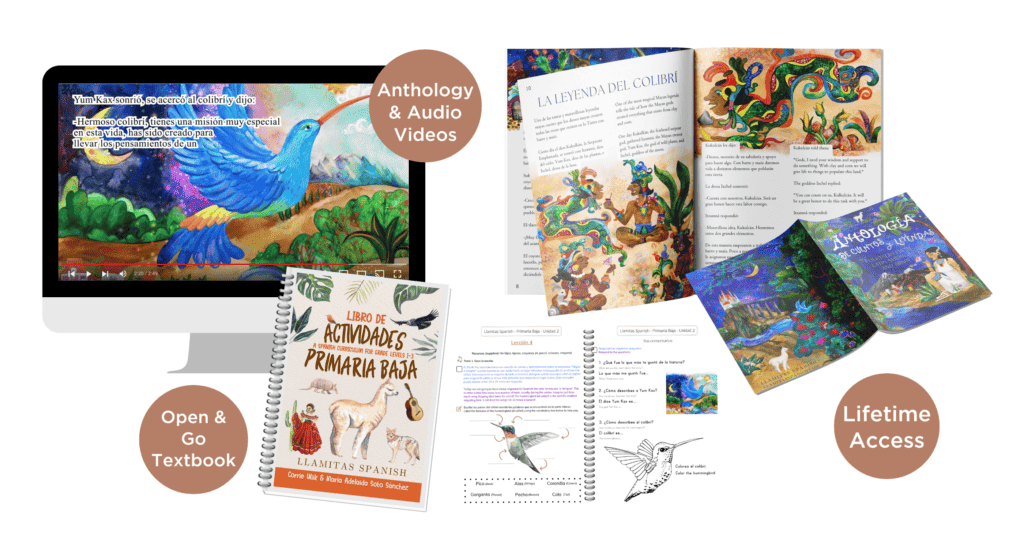In this post: Discover why comprehensible matters for effective language teaching and learning.
Language acquisition in children is a remarkable process. Until the age of about 6, research shows that the brain is most wired to absorb and learn languages effortlessly. This process is rooted in comprehensible input, a term coined by linguist Stephen Krashen.

Dr. Krashen has spent over 40 years developing this concept and has demonstrated that comprehensible input is the main type of brain stimulation that is truly essential for language acquisition to happen successfully.
If you’re raising a bilingual child and want to engage them with learning materials designed to emphasize comprehensible input as a learning methodology, the best place to begin is with our Llamitas Spanish Curriculum and subscribing to our Free Resource Library, where you’ll find fun and interactive resources that expand all the Spanish learning options for your little lingüista.
Table of Contents
What is Comprehensible Input?
Comprehensible input is a method of learning languages that focuses on providing children with language input that is slightly ahead of their current level of understanding, to help them acquire new language naturally.
Comprehensible input is simply language input that listeners can understand, even when they aren’t familiar with all of the words or phrases in any given statement.
In other words, it’s understanding new words and concepts thanks to the manner and context in which new words and concepts are introduced. When the input is comprehensible, the learner more easily understands the gist of what’s being said.
So, for example, while listening to music in Spanish helps to familiarize Spanish learners with the language, it achieves little if you have no other interaction with the Spanish language to help you understand what you are hearing!
For Spanish learners, providing effective comprehensible input could mean having the child hear new Spanish words and phrases that are slightly more advanced than what they already know.
To help clarify the meaning of these words and phrases the use of contextual clues such as visual aids, gestures, and other words and phrases that also appear in the same sentence or paragraph are extremely effective.
In its simplest terms, comprehensible input refers to
language input that is slightly beyond a learner’s current level but can still be understood with the help of context.
This is really the most effective way to expand a learner’s vocabulary and overall proficiency in any language.
So how can parents raising bilingual children optimize this approach?
Firstly, take advantage of our FREE Spanish Resource Library where you will find printable materials, as well as sing-along-songs, Spanish games, and many other learning resources to help you get started for free.
We update our content monthly with fresh new activities and learning resources that you can use to enhance your child’s Spanish learning journey and make it more fun!
Additionally, we will share some of our top tips for incorporating comprehensible input into your child’s language learning experience in this post!
The Importance of Comprehensible Input
Comprehensible input is language that expands a learner’s vocabulary, comprehension and fluency in a meaningful and relevant way, and is at the heart of effective language learning as it aligns with a child’s natural ability to acquire language.
In fact, even monolingual speakers use comprehensible input as a means to expand and develop a greater vocabulary in their native language. It is essentially the most natural, organic way to learn a language, and it happens pretty naturally as part of the natural process of learning to speak and communicate.
When children are exposed to language learning that is slightly more advanced than their current level, it challenges their cognitive abilities without overwhelming them.
Dr Krashen explains how feeling bored or overwhelmed can totally shut down the brain’s ability to learn languages, so finding that sweet spot where comprehensible input stimulates a new understanding really is key to keeping the brain’s receptivity at peak levels!
The key to maintaining this ongoing activity in the brain is to constantly provide learning materials and opportunities for language exposure that stretch the learner’s comprehension by only a few degrees, perhaps adding just a couple of new words, a new usage of a word, or another new concept.
This type of stimulation suddenly turns on the light in the child’s head and creates an unconscious “aha!” moment in which the learner suddenly and organically understands the new word or phrase or its new usage.

Benefits of Comprehensible Input for Children
- Enhanced Vocabulary Development: Comprehensible input exposes the language student to a wider range of words and phrases in specific contexts, enhancing the child’s ability to understand their meaning and usage.
- Improved Language Fluency: With expanded vocabulary comes increased fluency. When children receive comprehensible input, they develop a better understanding of language patterns, idiomatic expressions, grammar, and sentence structures in context. This not only expands their vocabulary but also their understanding of grammar and syntax in the target language.
- Increased Cultural Awareness: Beyond the linguistic benefits of comprehensible input, this type of natural, organic learning fosters an appreciation for the culture, values, and customs of the people and regions where the Spanish language is spoken. It helps children become global citizens and keeps them more connected to the context of the Spanish language as it is used throughout the world.
- Boosted listening skills: Tuning into native speaker’s accents and ‘natural’ language use is enhanced through comprehensible input. Understanding a second language is the first step towards producing it.
We provide parents with an extensive collection of resources that help to solidify these benefits. For example, Spanish sing-along songs that children can use to learn new words and phrases while watching videos, as well as books and stories that introduce children to customs and traditions from Spain and Latin America.
These resources can enhance the context provided for comprehensible input learning to take place naturally and in a fun manner.
Practical Tips for Maximizing Comprehensible Input
- Choose authentic and engaging materials: Provide your child with beautiful literature that is age appropriate. Think audiobooks, songs and stories that capture their interest. Visual aids are always helpful for maximizing comprehensible input, as well as engaging narratives.
Our Spanish Seasonal Units include songs, stories, pictures, and printable materials that can help you enhance your child’s learning experience with comprehensible input modalities built right into every lesson!
- Provide native speaker input: This can be hard if you are a non-native speaker, but in today’s connected world, it’s very achievable! Practical and real life language is key! In addition to exposing your child to native speakers at cultural events, you can help them to grow more accustomed to listening to native speaker voices by listening to our collection of Classic Spanish Folk Songs.
- Encourage Active Participation: Conversations can naturally happen through discussing great literature, or singing songs together.
Here’s a great link to a resource where your kids can listen to Spanish podcasts designed just for young Spanish learners! Mama Llama Linguists’ Top Spanish Podcasts for Kids
- Take advantage of technology: Story based online apps like Fabulingua, and online lessons with companies like Trufluency Kids, are great ways to increase comprehensible input on devices!
- Encourage! Half the battle with language learning is overcoming shyness. Foster a supportive environment where the child feels comfortable making mistakes- it’s how we learn!
Everyday Comprehensible Input Examples
There’s an abundance of ways to obtain comprehensible input in Spanish, but one common way is to watch TV or movies in the target language. Oftentimes, you can get a good idea of the plot just from the acting, but sometimes subtitles help as well.
Some popular options include graded readers, which are books written specifically for language learners at different levels of proficiency.
Another option is watching Spanish-language TV shows or movies with subtitles in your native language or in Spanish. Additionally, language learning apps offer interactive exercises and activities that provide comprehensible input in a fun and engaging way.
Llamitas Spanish Curriculum
At Llamitas Spanish, we understand the power of comprehensible input. Our curriculum levels are not dull textbooks, but living books with beautiful, engaging illustrations, captivating stories and plenty of opportunities to listen to native speakers (with hundreds of audio tracks!)
Our level 1 curriculum for Preschool and Kindergarten includes beautiful nursery rhymes, engaging games that get the child using the language in context, short stories with comprehension questions, bilingual readers and so much more!
Our level 2 curriculum includes another engaging textbook and a beautiful anthology with 6 authentic folktales that are rooted in Hispanic culture. Each story also includes and audio-video component to provide even more visual aids.
Our lessons are interactive and sequential, building upon phonics, math and literacy skills unit by unit.
Visit the curriculum shop today to get started!




